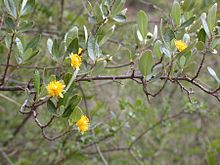- Pineda (plant)
-
Pineda 
Scientific classification Kingdom: Plantae (unranked): Angiosperms (unranked): Eudicots (unranked): Rosids Order: Malpighiales Family: Salicaceae Tribe: Prockieae[1] Genus: Pineda
Ruiz & Pav.Type species Pineda incana
Ruiz & Pav.Species Pineda incana, Pineda ovata
Synonyms - Christannia C.Presl
Pineda is a genus of flowering plants in the willow family, Salicaceae. It contains two species of shrubs: Pineda incana, which is native to the Andes of Ecuador and Peru, and Pineda ovata, which is native to the Andes of Bolivia.[2]
Pineda is unique among Salicaceae in that the species have 4-5 sepals and petals, hermaphroditic flowers, receptacular disk glands (=nectaries), and outer filamentous staminodes. It is one of few genera of Salicaceae that occur at high elevations.[2] Formerly placed in the heterogeneous family Flacourtiaceae,[3] Pineda is now classified in tribe Prockieae of Salicaceae, along with close relatives Prockia, Banara, Hasseltiopsis, and Neosprucea.[2]
Pineda was named in honor of Antonio Pineda, a Guatemalan botanist who was coordinator of the naturalists aboard the Pacific expedition of Alessandro Malaspina.[4]
Pineda incana is known as "lloqui," "lloque," "lloquecillos," or "manzanitas cimarronas," and Pineda ovata is known as "duraznillo." Pineda ovata is commonly misidentified as Prockia crucis (Salicaceae).[2]
References
- ^ Lemke, D.E. 1988. A synopsis of Flacourtiaceae. Aliso 12: 29-43.
- ^ a b c d Alford, M.H. 2006. A taxonomic revision of the Andean genus Pineda (Salicaceae). Kew Bulletin 61: 205-214.
- ^ Sleumer, H.O. 1980. Flacourtiaceae. Flora Neotropica 22: 1-499.
- ^ Ruiz, H. and J. Pavón. 1794. Flora Peruvianae, et Chilensis Prodromus. Madrid, Spain.
External links
This Salicaceae article is a stub. You can help Wikipedia by expanding it.
